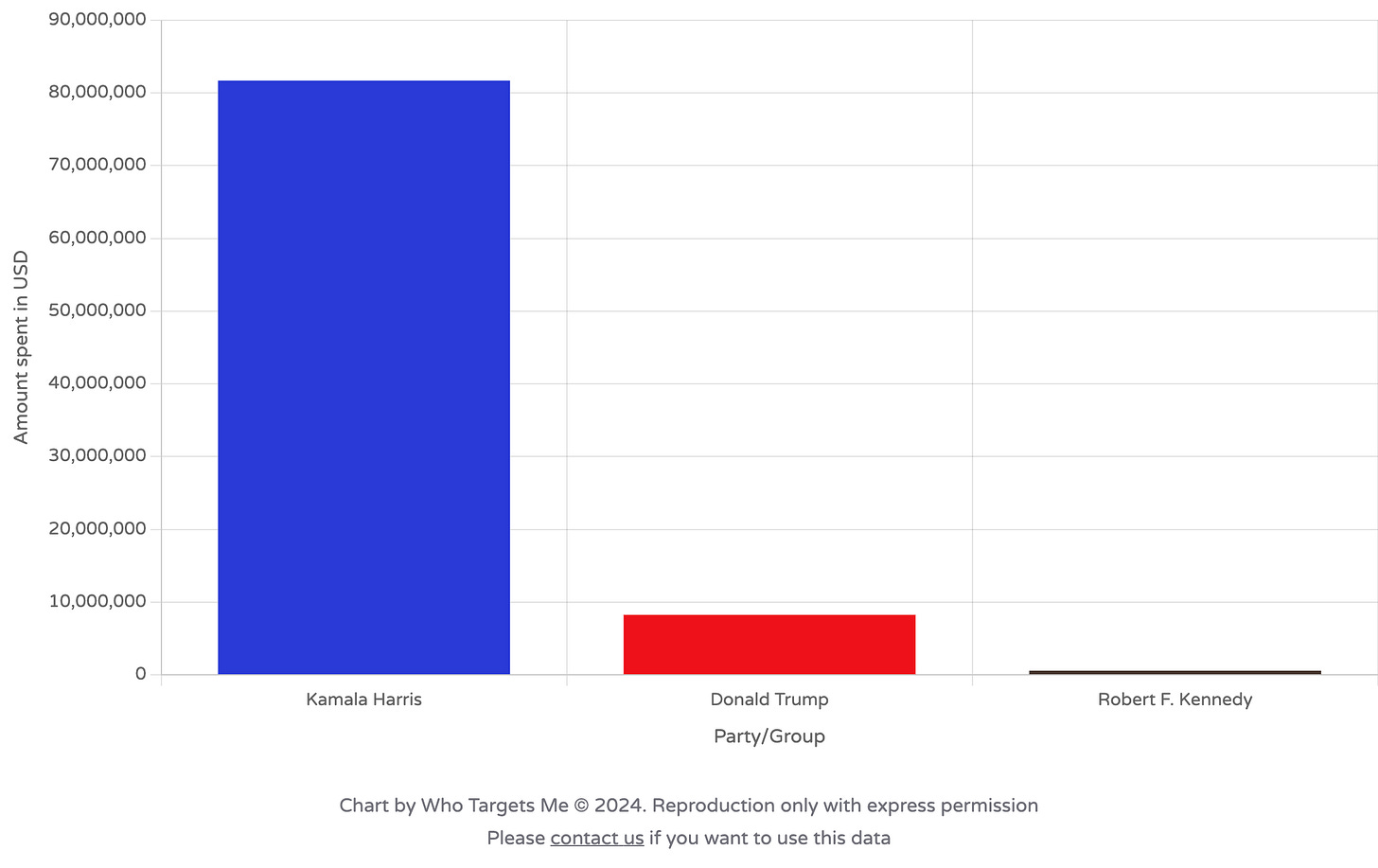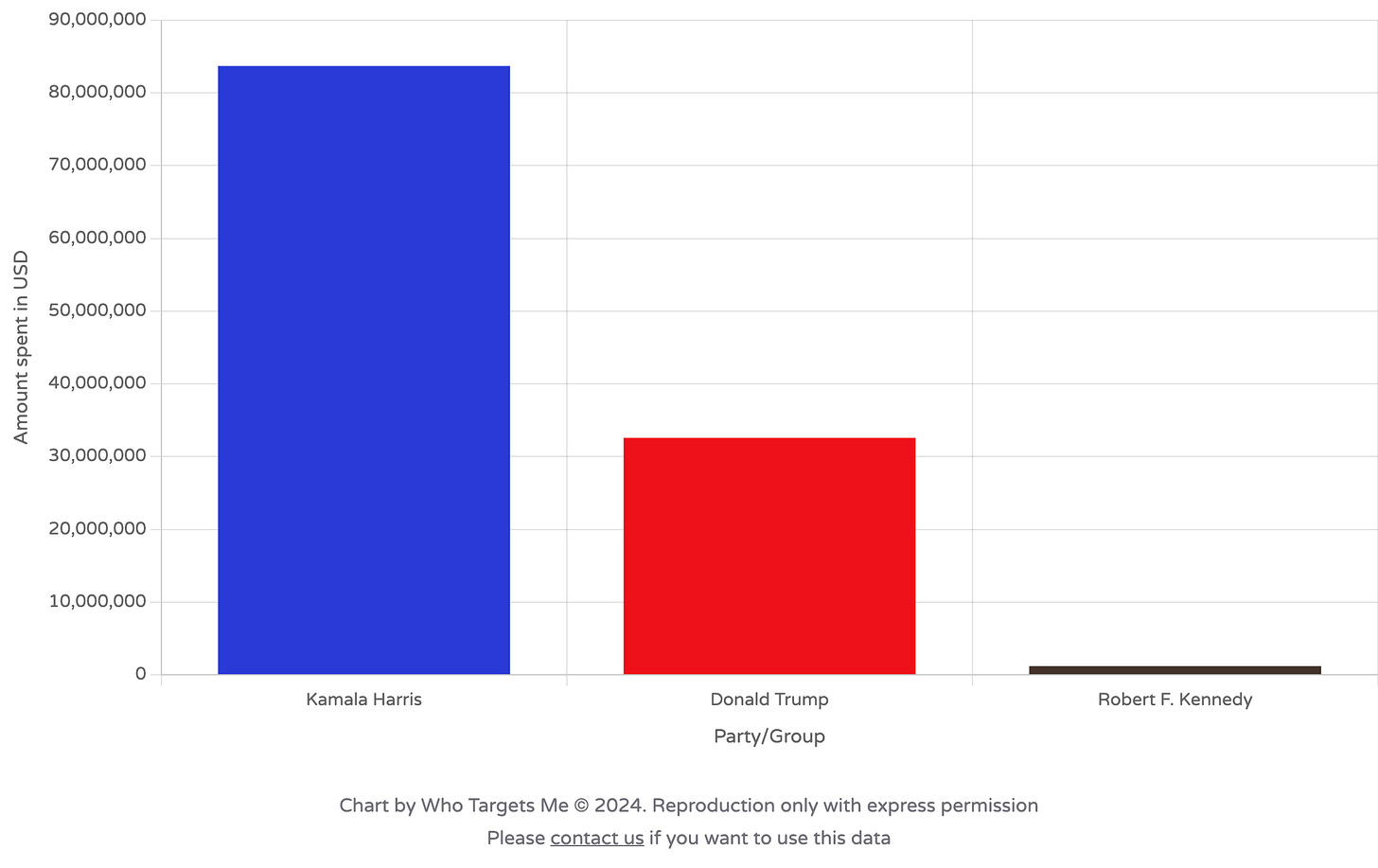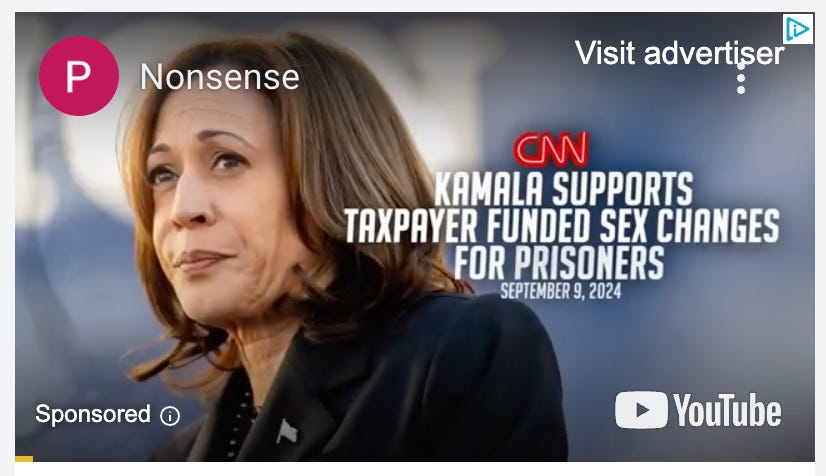Less than 30 days to go...
🇺🇸 CNN: MUSIC STARTS, HUGE TEXT APPARENTLY MADE OF MARBLE SWEEPS IN. "AMERICA DECIDES". 🇺🇸
Hi there,
After a post-UK election hiatus, we’re back with a US-focused edition of Full Disclosure.
Below, we run through all of the Who Targets Me tools that shed light on how the campaigns are using digital ads in the race for the White House. We’ve picked out some highlights of what we’re seeing across digital ad spending, targeting and messaging with a month to go.
Remember - these are tools you can explore for for yourself, so please go ahead and have a go. We hope you find them useful.
Anyway, on with the data.
1) Kamala Harris is massively outspending Trump on Facebook, Instagram and YouTube.
This is Harris versus Trump (and a little bit of Kennedy) on Meta over the last three months. Harris has bought over $80m of ads, Trump less than $10m.
Here’s the same chart, but for Google and YouTube spending:
Again, Harris is over $80m, Trump is still way behind, but here has spent over $30m.
Despite apparently being propelled to the Presidency by his social media posts, the Trump campaign seems not to like digital very much. Their relative preference for YouTube seems borne out of it being more like TV than any particular strategic benefits. Some Republican strategists are worried about this, though he is spending heavily on TV and direct mail (one estimate thinks he’s outspending Harris on that channel 10 to 1). At this point, you might argue that this Trump campaign, as opposed to the 2016 and 2020 versions, is Trump redux. He’s only doing the things he likes (grift and rallies) and outsourcing the rest to allies like Elon Musk and supportive PACs.
You can dig into all this data on our Trends dashboard for the US, where we’re tracking all of the pages associated with the presidential campaigns, as well as over 30,000 others.
2) The parties are competing to reach Latino voters
Right now, the most politically competitive interests on Facebook and Instagram are all related to Latino audiences (see the “Contested Audiences” tab). A few years ago, Meta banned the use of race as a targeting criteria for political ads. This data shows how the parties work around that. But it also shows that both parties consider Latino voters to be important this time around, with the Democrats on the defensive, fearing that Trump might further increase his vote share among this group (as he did in 2020). For decades Latino voters were reliably blue, but Trump seems to be changing that, and his party is targeting them to try and seal the deal.
It’s also quite *fun* to look at who the Democrats want to avoid showing ads to. Yes, those do seem like quite Republican things.
Lastly, note how Trump doesn’t really bother with younger voters at all on Facebook. Nearly half of his ads actively avoid reaching the under 35s.
That’s a very different profile to Harris, who mostly reaches all age groups.
We’re grateful to Dr. Fabio Votta at UvA for his work building these dashboards and aggregating the targeting data across thousands of advertisers.
3. Harris dominates the swing states on Meta
Here’s a county-by-county map of where the two presidential campaigns are geotargeting ads (by zipcode etc).
To build this, we exclude the majority of fundraising advertising (which largely uses Custom and Lookalike Audiences to target donors directly) leaving behind only the ads designed to persuade and mobilise voters in the swing states.
If a county is blue, it means Harris is outspending Trump there (darker = by more), if it’s red, Trump is in the lead and if it’s purple, it’s level or level-abouts. As you can see, there are very few red counties.
You can also see neither side has much up its sleeve. The swing states are the ones everyone knows about. No-one’s wasting any cash on Texas or Florida. You can also see that Harris is even outspending Trump in Nebraska, where a single electoral college vote is up for grabs. It’s close enough for that to matter.
The map (which is a bit slow, so be patient - there’s a lot of data going on), allows you to look at the Presidential campaign, Republicans vs. Democrats and the entire ecosystem of Meta political advertisers in the US (all 30,000+ in our system). You can also look at rolling week or month long periods to see how it changes over time. Clicking a county shows who we’ve found advertising there along with an estimate of how much they’ve spent doing so.
4) Harris moves to persuasion and mobilisation, Trump focuses on rallies and voter registration in swing states, both attack each other
After months of primarily fundraising advertising, the balance of the Harris digital ad campaign has switched to issues (tax cuts for the middle class, Trump’s position on banning abortion, support for small businesses among others) and mobilisation (asking voters in swing states to start returning their postal ballots).
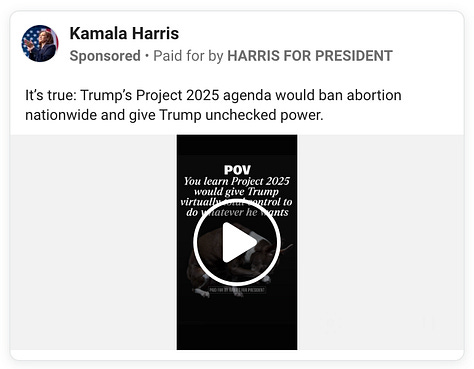




On Meta, Trump is still promoting rallies (though not always his own - JD Vance appears in many of the current ads), though is also pushing last minute voter registration across several swing states, and appealing for votes. None of the ads make more than a passing mention of his policy plans.


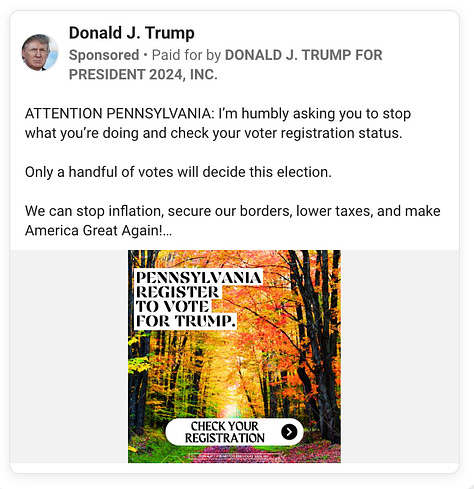
To make it easier to see what’s happening across the thousands of ads each campaign is currently running, we’ve built an AI-powered tool that summarises the content of the promoted content from both the Trump and Harris campaigns (scroll to the bottom of each page for those).
For their YouTube ads, both campaigns go on the attack, with messages just like the ones you’d see on TV (where a lot of YouTube is actually watched). You just need to see a screenshot of one of the ads to know exactly how it plays - that deep American attack ad voiceover, the black and white bit, the brooding music.
Here’s a Trump YouTube ad, seen millions of times, accusing Harris of supporting “taxpayer funded sex changes for prisoners and illegal aliens”:
And here’s one from Harris on Trump’s “Project 2025” that would give Trump “unprecedented, unchecked power, to do whatever he wants”:
No one really likes attack ads, except political campaigns.
5) Lastly, a plug (in). The Who Targets Me browser extension now tracks ads across platforms.
After 7 years of tracking Facebook ads, we’ve expanded the functionality of our browser extension. It now tracks political ads across Facebook, Instagram, Twitter/X and YouTube (reminder - no paid political ads on TikTok and doing this for display advertising would be insurmountably hard, we think).
We are working with the Universities of Syracuse (NY) and Manchester (UK) to try and understand more about how people experience political ads on different platforms. If you’re in the US and want to help, please install the extension and take their survey. Give it a share too - more people install it when you do.
Over the next few weeks, we’ll be updating the displays in the extension to display data from all of the new services we’ve added (at the moment, it’s only tracking the ads for the university study).
Thanks!
Thanks for reading. Remember, please take a look at Trends, install the Who Targets Me browser extension and, if you liked this and want to support our work and tools, please consider taking out a paid subscription or making a donation.
All the best,
Who Targets Me
P.s. If you’re a journalist covering campaigns, political ads, tech etc and want to learn more about political ads and using the sorts of data we’re covering in this newsletter, we now offer training. Get in touch if you want to learn more.



